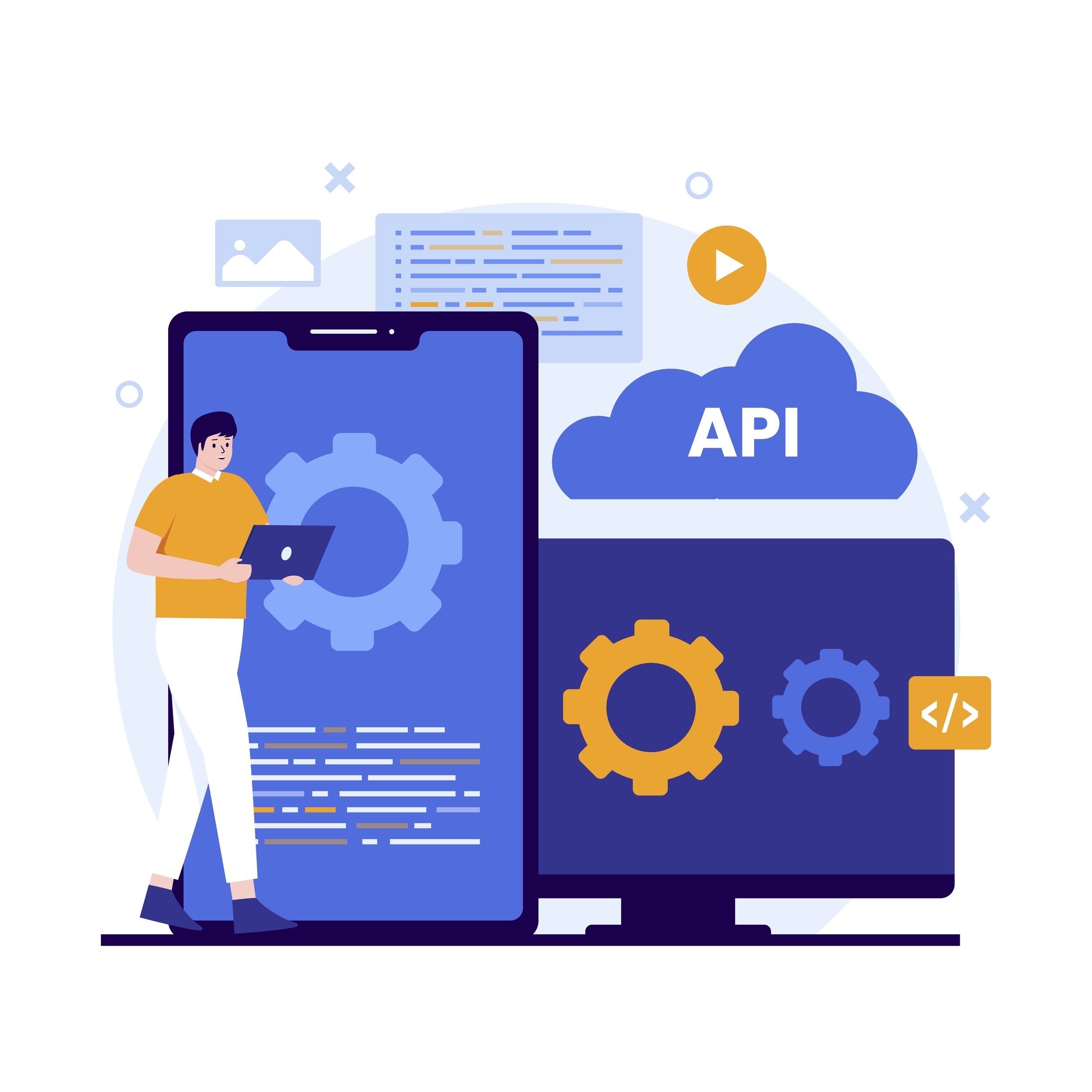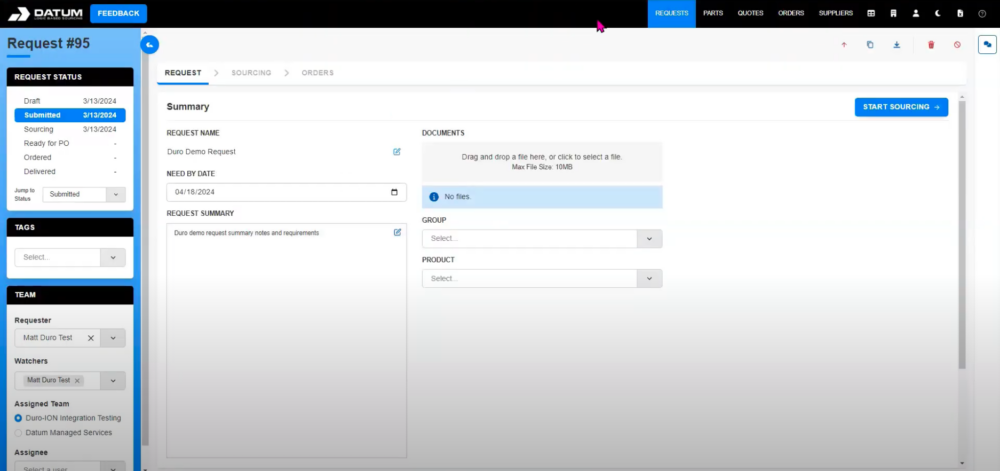
From Part Release to Order in Minutes: The Datum Source – Duro Integration
Sophia Barnett, Content and Technical Writer
Procurement processes are notoriously complex, and manual data entry makes them even more error-prone. Buyers may accidentally purchase the wrong parts, wasting money if they’re not aware that there’s a modification in process or there’s a revision of the part. Fortunately, there’s a solution. Duro’s integration with Datum Source simplifies procurement, saving time and money by ensuring accurate, informed procurement decisions. In this blog, we’ll discuss how the Datum-Duro integration addresses some of the challenges with procurement. We’ll also dive into the specific benefits and how the integration works.
Learn more below:
- Who is Datum
- Procurement processes are prone to error
- How Duro’s integration with Datum Source facilitates accurate procurement
- How the integration works
Who is Datum?
Datum Source is a procurement solutions provider primarily working with aerospace, defense, and energy companies. Datum helps to facilitate every step of the procurement process, from managing your approved vendor list to creating, approving, and issuing purchase orders. Their mission is not to replace existing tools such as ERP or MES but rather to augment them. Engineers use the platform to submit requisitions, manage quotes, and track orders, whereas buyers use the platform to manage suppliers, solicit RFQs, and create purchase orders.
Procurement processes are prone to error
Robert Pakalsi, CEO and Co-founder of Datum Source describes today’s procurement process as a “black hole.” There’s a broken link between BOM design and parts sourcing that creates a data disconnect. Ordering the wrong components because there’s no connection between the part library and the requisition intake wastes thousands of dollars.
According to Tech Clarity, hardware engineers only spend about 54% of their time actually designing products. They end up wasting time on non-value-adding tasks related to BOM and sourcing misalignment. Engineers must manually input the component data, including every part number, revision value, lifecycle status, granular spec, and associated Change Order, into procurement platforms, which is incredibly tedious and time-consuming. Ultimately, this hinders product innovation and profitability for hardware companies. However, more concerning is that with a manual data transfer, the potential for errors to occur increases exponentially.
“Highly sophisticated companies with brilliant engineers were coming up with makeshift ways to facilitate procurement.”
– Robert Pakalsi, CEO and Co-founder, Datum Source
Furthermore, relying on manual data entry makes companies less competitive in an evolving marketplace, especially when market shifts have negative downstream impacts within the supply chain. Companies anchored to sluggish manual processes and lacking adaptability are further disadvantaged if they don’t possess the necessary tools for rapid adjustment. This delay in responsiveness hinders their time to market, making them less able to capitalize on opportunities or mitigate risks as swiftly as their competitors.
How Duro’s integration with Datum Source facilitates accurate procurement
The Datum Source/Duro integration solves the procurement problem by empowering buyers to make accurate and well-informed procurement decisions. Duro, as the central PLM (Product Lifecycle Management) system, acts as the single source of truth for product data and part numbers. Datum Source establishes a live connection with Duro, automatically mirroring any changes to parts and their attributes.
To optimize file management, part files are transferred when a part is added to a procurement requisition, ensuring the buying team receives the latest information only when it’s needed for the procurement process.
The integration fully eliminates the need to download or upload files locally from Duro, thereby eliminating the cumbersome process of attaching files to emails for supplier communication. Instead, files are shared securely with suppliers via Datum’s embedded supplier portal.
Most importantly, the connection prevents buyers from purchasing the incorrect parts. Unlike designers and engineers who have a more hands-on role with BOM design in Duro, buyers may not immediately be aware of part or process modifications within the PLM system. The integration creates a stopgap, notifying buyers about open Change Orders. Specifically, when in Datum you will see an Open Change Order flag as soon as an ECO is in process or new files have been added.
By using Duro with Datum Source, manufacturers can improve data accuracy across teams, avoid part obsolescence, simplify supplier relationship management, reduce costly procurement errors, and ensure a smoother manufacturing process. Benefits of the integration include:
- Accurate Procurement Decisions: Real-time data synchronization ensures procurement teams always work with the latest part files and information.
- Prevention of Costly Errors: Alerts buyers to open change orders, enabling consultations with engineering before purchasing and preventing costly mistakes due to outdated parts.
- Reduced Risk: Flags potential design changes before purchases, avoiding rework and saving procurement teams time and money.
- Secure File Sharing: Facilitates ITAR-compliant file transfers with suppliers, eliminating the security risks associated with traditional file downloads.
How the integration works
Synchronizing parts between Duro and Datum
The integration maps part information directly from Duro into Datum, encompassing your entire part library. Quickly transfer component details, manufacturer/distributor data, categories, and links back to the part in Duro. Additionally, you can configure fields in Datum to match your preferences.
Importantly, part numbers and revisions originate exclusively from Duro and are non-editable in Datum. This unidirectional control guarantees consistency, with part name updates in Duro automatically reflected within Datum.
A new Change Order generates an update in Datum
Change Orders continue to be initiated in Duro, and new revisions are automatically synced to Datum. Part revisions are marked as inactive in Datum, so the entire sourcing history of a part is maintained.

Changes in Duro are reflected in Datum
Altering a part in Duro, for example, adding a new document triggers a modification flag. This clear signaling alerts stakeholders to the change and prevents the risk of buying parts with an in-process modification or an ECO. Buyers can easily collaborate with engineers to stop a purchase or understand the implications of the design modification.
Datum enhances communication and transparency through its notification system. Throughout the process, relevant parties receive notifications about product updates, such as RFQ responses, changes to quotes, requests for Change Orders, and the generation of purchase orders. These notifications maintain a clear flow of information and accountability.
Requisitions in Datum pull in part files
Requisitions within Datum serve as a key event trigger. When a part is added to a requisition, the latest part files are transferred from Duro, guaranteeing that Datum only reflects the most up-to-date information.
An integrated RFQ tool and supplier portal streamline secure file transfers to suppliers Datum’s supplier portal. Additionally, it facilitates the process of sending the request for quote (RFQ) to potential suppliers with relevant files. This completely eliminates the need to download and re-upload files.

Supplier management in Datum
Suppliers receive the RFQ directly within the Datum platform and can submit their responses without leaving the system. This reduces the reliance on external email communication, keeping the entire process organized and efficient. Once the team chooses a supplier, they create a quote within Datum. If configured, Datum triggers a designated approval process for the quote, ensuring proper review before moving forward. Then, you can use Datum to generate a purchase order directly. This purchase order can then integrate with various ERP or MES systems that you might be using.
Takeaways & next steps
The integration between Duro and Datum Source helps prevent errors in procurement. By maintaining real-time data synchronization, flagging design changes, and facilitating ITAR-compliant file transfers, the Duro/Datum Source integration drastically streamlines the entire procurement process.
If you’re looking to optimize your product development operations and make data-driven procurement decisions, the Duro and Datum Source integration is a must-have. Schedule a demo here.